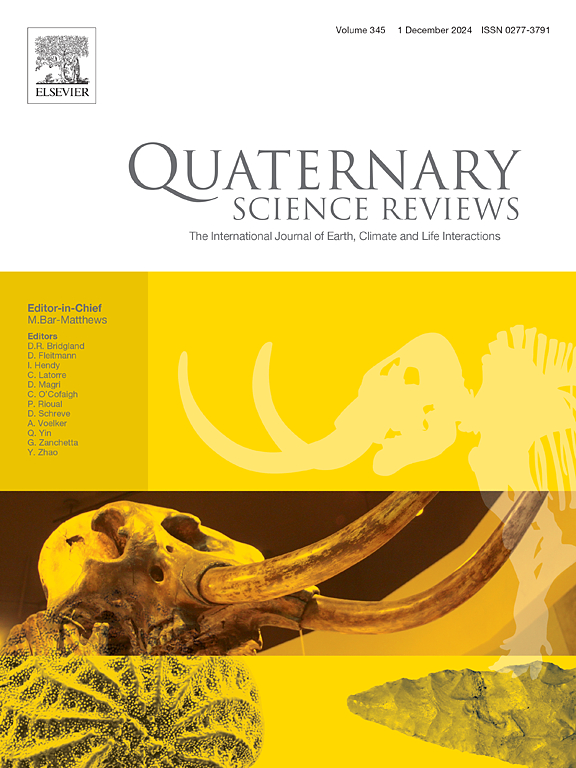近两个冰期-间冰期旋回中国南方C3/C4植被动态及水文气候变化
IF 3.3
1区 地球科学
Q1 GEOGRAPHY, PHYSICAL
引用次数: 0
摘要
东亚热带-亚热带季风区的气候和环境对内部和外部强迫的响应仍然知之甚少,这主要是由于缺乏跨越多个冰期-间冰期旋回的高分辨率陆地记录。本文研究了华南热带地区广东省天阳玛尔湖的有机碳同位素(δ13Corg)记录,时间跨度约为250kyr。这一记录反映了在轨道时间尺度上当地陆地植被C3和C4生物量相对丰度的显著变化,我们认为这主要是由区域降水变化驱动的。具体来说,C4植物在较干燥的冰期气候中占主导地位,而C3植物在间冰期较潮湿的条件下茁壮成长。在冰期-间冰期交替叠加下,C3/C4植被组成和相关降水呈现高频波动,相应的光谱分析显示出明显的半岁差信号。这表明研究区域的生态系统和水文气候动力学与轨道时间尺度上的赤道日照之间存在联系,而El Niño/南方涛动(ENSO)样变率可能是一个桥梁机制。我们的研究结果强调了冰川和低纬度日照强迫对热带东亚陆地生态系统和水文气候的综合影响,从而增强了我们对晚第四纪东亚夏季风(EASM)变率和强迫机制的理解。本文章由计算机程序翻译,如有差异,请以英文原文为准。
C3/C4 vegetation dynamics and hydroclimate variations in South China over the last two glacial-interglacial cycles
The responses of climate and environment in the tropical-subtropical monsoon region of East Asia to both internal and external forcings remain poorly understood, largely due to the scarcity of high-resolution terrestrial records that span multiple glacial-interglacial cycles. In this study, we present an organic carbon isotope (δ13Corg) record from Tianyang maar lake in Guangdong Province, tropical South China, covering the past ∼250 kyr. This record reflects significant variations in the relative abundance of C3 and C4 biomass in the local terrestrial vegetation at orbital timescales, which we contend are primarily driven by changes in regional precipitation. Specifically, C4 plants dominate in the drier climates of glacial periods, while C3 plants thrive in the more humid conditions of interglacial periods. Superimposed on glacial-interglacial alternations, C3/C4 vegetation composition and associated precipitation exhibit high-frequency fluctuations, for which corresponding spectral analysis reveals prominent half-precession signals. This suggests a linkage between the ecosystem and hydroclimate dynamics in the study region and equatorial insolation at orbital timescales, with El Niño/Southern Oscillation (ENSO)-like variability possibly acting as a bridging mechanism. Our findings highlight the combined influence of glacial and low-latitude insolation forcings on terrestrial ecosystems and hydroclimate in tropical East Asia, thereby enhancing our understanding of the variability and forcing mechanisms of the East Asian Summer Monsoon (EASM) during the late Quaternary.
求助全文
通过发布文献求助,成功后即可免费获取论文全文。
去求助
来源期刊

Quaternary Science Reviews
地学-地球科学综合
CiteScore
7.50
自引率
15.00%
发文量
388
审稿时长
3 months
期刊介绍:
Quaternary Science Reviews caters for all aspects of Quaternary science, and includes, for example, geology, geomorphology, geography, archaeology, soil science, palaeobotany, palaeontology, palaeoclimatology and the full range of applicable dating methods. The dividing line between what constitutes the review paper and one which contains new original data is not easy to establish, so QSR also publishes papers with new data especially if these perform a review function. All the Quaternary sciences are changing rapidly and subject to re-evaluation as the pace of discovery quickens; thus the diverse but comprehensive role of Quaternary Science Reviews keeps readers abreast of the wider issues relating to new developments in the field.
 求助内容:
求助内容: 应助结果提醒方式:
应助结果提醒方式:


